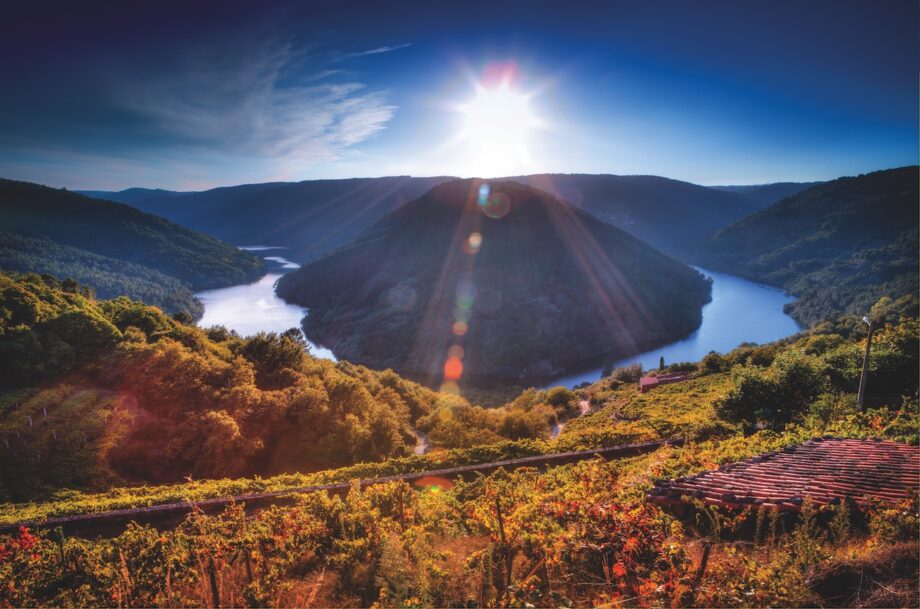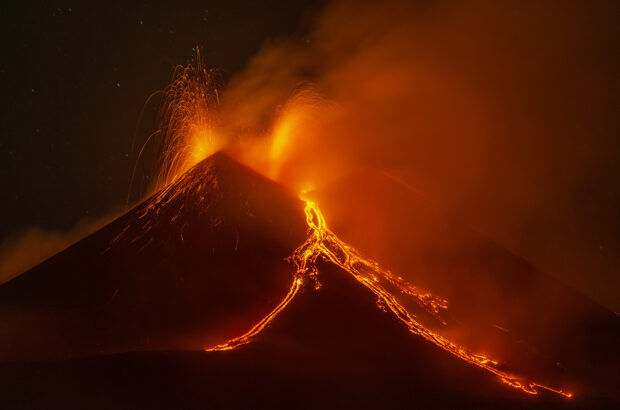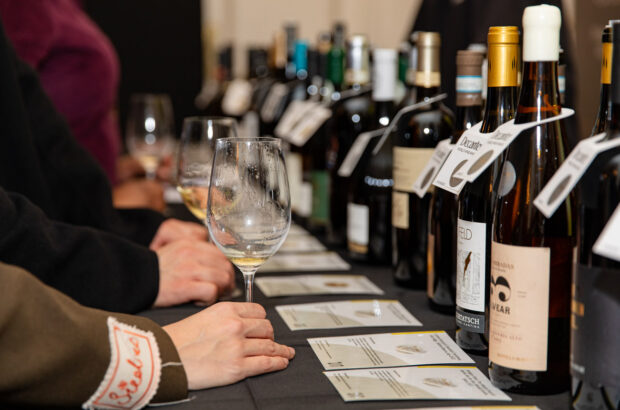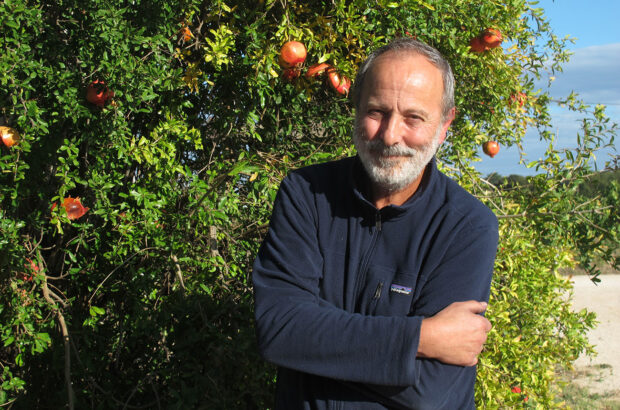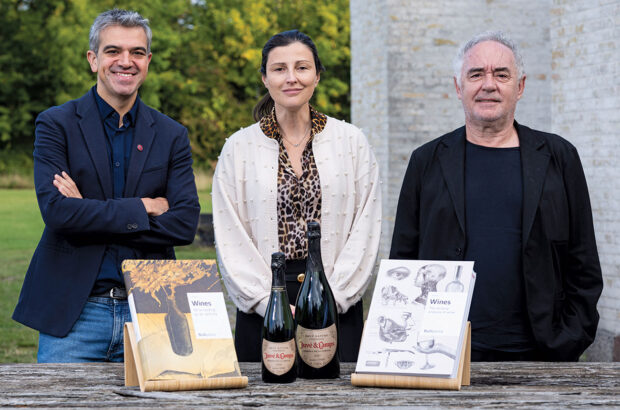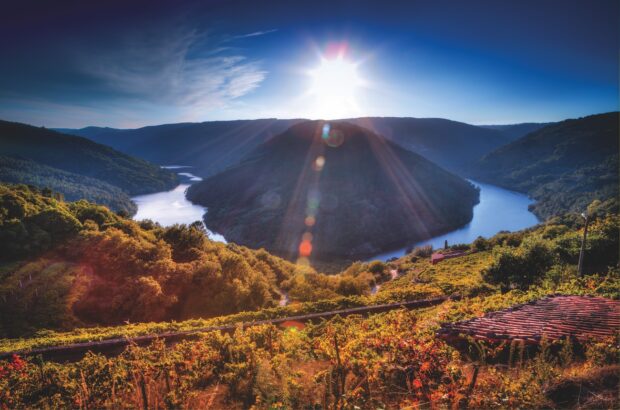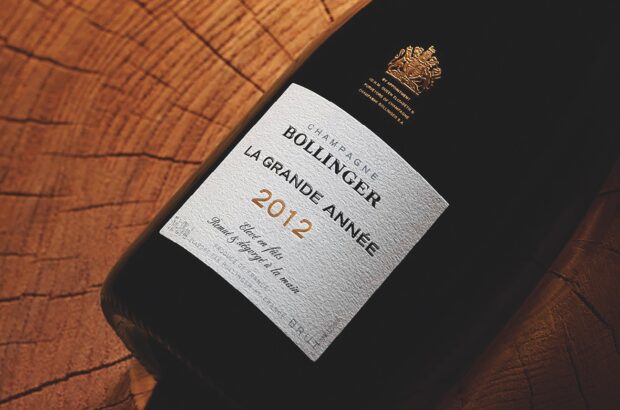Between the 8th and 9th centuries, Christian monastic orders came in great numbers to central Galicia, searching for solitary places to pray. They found what they were looking for in the Miño and Sil river canyons.
Carved out by tectonic forces over millions of years, the slopes of these deep valleys reach near-vertical inclines in some places, discouraging any unwanted passers-by.
The numerous resulting monasteries that cling to these slopes would inspire the modern wine region’s name: Ribeira Sacra, or ‘sacred riverbank’. People have been cultivating vines here for centuries, carving terraces from unforgiving granite and slate and painstakingly carrying baskets of grapes up the impossibly steep slopes.
This is one of Europe’s great terraced landscapes, deserving to be mentioned in the same breath as Côte-Rôtie, Mosel or the Douro. But Ribeira Sacra has never received the same recognition.
Part of that might be due to its geographical barriers and historical struggles. Its isolation was great for the monks, but not so great for the wine trade.
And once the railways came to Galicia in the 1800s, many growers couldn’t compete with the cheaper wine arriving from flat, fertile Castilla y León to its west.
Faced with hardship, huge numbers of people abandoned their vines and left the countryside – a trend that continued into and throughout the 20th century and, in smaller measure, continues today.
{"content":"PC9wPgo8ZGl2IGNsYXNzPSJhZC1jb250YWluZXIgYWQtY29udGFpbmVyLS1tb2JpbGUiPjxkaXYgaWQ9InBvc3QtaW5saW5lLTMiIGNsYXNzPSJpcGMtYWR2ZXJ0Ij48L2Rpdj48L2Rpdj4KPGgyPkEgcmV2aXZhbDwvaDI+CjxwPkFzIFNwYWluIG1vdmVkIGJhY2sgdG8gZGVtb2NyYWN5IGZyb20gMTk3NSBhbmQgYmVnYW4gdG8gb3BlbiB1cCwgbmV3IG9wcG9ydHVuaXRpZXMgY2FtZSBjYWxsaW5nLCBicmluZ2luZyBib3RoIG1vbmV5IGFuZCBuZXcgd2luZW1ha2luZyB0ZWNobm9sb2d5IHRvIHRoZSBjb3VudHJ5c2lkZS48L3A+CjxwPkJ5IHRoZSBlYXJseSAxOTkwcywgYSBmZXcgcGlvbmVlcmluZyBsb2NhbCBncm93ZXJzIGhhZCBqb2luZWQgZm9yY2VzIHRvIGNyZWF0ZSBhbiBvZmZpY2lhbCB3aW5lIHJlZ2lvbiBhbmQsIGluIDE5OTYsIFJpYmVpcmEgU2FjcmEgYmVjYW1lIGEgRGVub21pbmFjacOzbiBkZSBPcmlnZW4uPC9wPgo8ZGl2IGNsYXNzPSJhZC1jb250YWluZXIgYWQtY29udGFpbmVyLS1tb2JpbGUiPjxkaXYgaWQ9InBvc3QtaW5saW5lLTQiIGNsYXNzPSJpcGMtYWR2ZXJ0Ij48L2Rpdj48L2Rpdj4KPHA+Tm93LCBuZWFybHkgMzAgeWVhcnMgYWZ0ZXIgZ2FpbmluZyBETyBzdGF0dXMsIEdhbGljaWHigJlzIG1vc3QgaGVyb2ljIHdpbmUgcmVnaW9uIChzZWUgYm94IGJlbG93KSBpcyBmaW5hbGx5IGNvbWluZyBpbnRvIGl0cyBvd24g4oCTIGV2ZW4gYXMgaXQgZmFjZXMgc29tZSBmYW1pbGlhciBjaGFsbGVuZ2VzLiBBcyBTcGFpbiByZWNrb25zIHdpdGggYSBjaGFuZ2luZyBjbGltYXRlLCB0aGUgbGlnaHQsIGZsb3JhbCwgYWNpZGl0eS1kcml2ZW4gcmVkIHdpbmVzIG9mIFJpYmVpcmEgU2FjcmEgbWF5IGhlbHAgdG8gZnV0dXJlLXByb29mIHRoZSByZWdpb24uPC9wPgo8cD5BdCB0aGUgc2FtZSB0aW1lLCBhIGdsb2JhbCBkZWNsaW5lIGluIHJlZCB3aW5lIGNvbnN1bXB0aW9uLCBhbmQgYSBsYWNrIG9mIHlvdW5nIHBlb3BsZSB0byB0YWtlIG9uIHRoZSBzdHJlbnVvdXMgdml0aWN1bHR1cmFsIHdvcmsgdGhlaXIgcGFyZW50cyBhbmQgZ3JhbmRwYXJlbnRzIHN0YXJ0ZWQsIHRocmVhdGVuIHRvIHF1YXNoIGFueSBzdWNjZXNzIGFjaGlldmVkIHRodXMgZmFyLjwvcD4KPGRpdiBjbGFzcz0iYWQtY29udGFpbmVyIGFkLWNvbnRhaW5lci0tbW9iaWxlIj48ZGl2IGlkPSJwb3N0LWlubGluZS01IiBjbGFzcz0iaXBjLWFkdmVydCI+PC9kaXY+PC9kaXY+CjxwPkJ1dCBub3QgYWxsIGlzIGxvc3Q6IGEgbmV3IGdlbmVyYXRpb24gb2Ygd2luZW1ha2VycyBpcyB0YWtpbmcgb3ZlciwgbWFraW5nIG1vcmUgaW5ub3ZhdGl2ZSBjaG9pY2VzIHRoYW4gZXZlciwgYW5kIHdvcmtpbmcgdG8gYnJpbmcgcHVibGljIHBlcmNlcHRpb24gb2YgUmliZWlyYSBTYWNyYSBpbiBsaW5lIHdpdGggdGhlIGh1Z2UgYW1vdW50IG9mIHdvcmsgaXQgdGFrZXMgdG8gZ3JvdyBhbmQgbWFrZSB3aW5lIG9uIHRoZSBiYW5rcyBvZiB0aGUgTWnDsW8gYW5kIFNpbC48L3A+CjxwPkhlcmUgd2UgaW50cm9kdWNlIGVpZ2h0IHByb2R1Y2VycyB3aG8gYXJlIGRyaXZpbmcgdGhhdCBjaGFuZ2UuPC9wPgo8aHI+CjxoMj5GZXJuYW5kbyBHb256w6FsZXo8L2gyPgo8aDM+QWRlZ2EgQWxndWVpcmE8L2gzPgo8ZGl2IGlkPSJhdHRhY2htZW50XzU2OTkyOSIgc3R5bGU9IndpZHRoOiA2NDBweCIgY2xhc3M9IndwLWNhcHRpb24gYWxpZ25ub25lIj48aW1nIGZldGNocHJpb3JpdHk9ImhpZ2giIGRlY29kaW5nPSJhc3luYyIgYXJpYS1kZXNjcmliZWRieT0iY2FwdGlvbi1hdHRhY2htZW50LTU2OTkyOSIgY2xhc3M9Imxhenlsb2FkIGJsdXItdXAgd3AtaW1hZ2UtNTY5OTI5IHNpemUtbGFyZ2UiIGRhdGEtcHJvY2Vzc2VkIHNyYz0iaHR0cHM6Ly93d3cuZGVjYW50ZXIuY29tLm1hc3Rlci5wdWJsaWMua2V5c3RvbmUtcHJvZC1la3MtZXV3MS5mdXR1cmVwbGMuZW5naW5lZXJpbmcvd3AtY29udGVudC90aGVtZXMvc2ltYmEtdGhlbWUvYXNzZXRzL2ltYWdlcy9wbGFjZWhvbGRlci5wbmciIGRhdGEtc3JjPSJodHRwczovL2tleWFzc2V0cy50aW1laW5jdWsubmV0L2luc3BpcmV3cC9saXZlL3dwLWNvbnRlbnQvdXBsb2Fkcy9zaXRlcy8zNC8yMDI1LzExL0RFUzMxNi5yaWJlaXJhX3NhY3JhLmZlcm5hZG9fZ29uemFfbGV6X2NyZWRpdF9jbGF5X21jbGFjaGxhbi02MzB4NTMxLmpwZyIgYWx0PSIiIHdpZHRoPSI2MzAiIGhlaWdodD0iNTMxIiBkYXRhLXNpemVzPSJhdXRvIiBkYXRhLXNyY3NldD0iaHR0cHM6Ly9rZXlhc3NldHMudGltZWluY3VrLm5ldC9pbnNwaXJld3AvbGl2ZS93cC1jb250ZW50L3VwbG9hZHMvc2l0ZXMvMzQvMjAyNS8xMS9ERVMzMTYucmliZWlyYV9zYWNyYS5mZXJuYWRvX2dvbnphX2xlel9jcmVkaXRfY2xheV9tY2xhY2hsYW4tNjMweDUzMS5qcGcgNjMwdywgaHR0cHM6Ly9rZXlhc3NldHMudGltZWluY3VrLm5ldC9pbnNwaXJld3AvbGl2ZS93cC1jb250ZW50L3VwbG9hZHMvc2l0ZXMvMzQvMjAyNS8xMS9ERVMzMTYucmliZWlyYV9zYWNyYS5mZXJuYWRvX2dvbnphX2xlel9jcmVkaXRfY2xheV9tY2xhY2hsYW4tMzAweDI1My5qcGcgMzAwdywgaHR0cHM6Ly9rZXlhc3NldHMudGltZWluY3VrLm5ldC9pbnNwaXJld3AvbGl2ZS93cC1jb250ZW50L3VwbG9hZHMvc2l0ZXMvMzQvMjAyNS8xMS9ERVMzMTYucmliZWlyYV9zYWNyYS5mZXJuYWRvX2dvbnphX2xlel9jcmVkaXRfY2xheV9tY2xhY2hsYW4tMTM1eDExNC5qcGcgMTM1dywgaHR0cHM6Ly9rZXlhc3NldHMudGltZWluY3VrLm5ldC9pbnNwaXJld3AvbGl2ZS93cC1jb250ZW50L3VwbG9hZHMvc2l0ZXMvMzQvMjAyNS8xMS9ERVMzMTYucmliZWlyYV9zYWNyYS5mZXJuYWRvX2dvbnphX2xlel9jcmVkaXRfY2xheV9tY2xhY2hsYW4tMzIweDI3MC5qcGcgMzIwdywgaHR0cHM6Ly9rZXlhc3NldHMudGltZWluY3VrLm5ldC9pbnNwaXJld3AvbGl2ZS93cC1jb250ZW50L3VwbG9hZHMvc2l0ZXMvMzQvMjAyNS8xMS9ERVMzMTYucmliZWlyYV9zYWNyYS5mZXJuYWRvX2dvbnphX2xlel9jcmVkaXRfY2xheV9tY2xhY2hsYW4tNjIweDUyMi5qcGcgNjIwdywgaHR0cHM6Ly9rZXlhc3NldHMudGltZWluY3VrLm5ldC9pbnNwaXJld3AvbGl2ZS93cC1jb250ZW50L3VwbG9hZHMvc2l0ZXMvMzQvMjAyNS8xMS9ERVMzMTYucmliZWlyYV9zYWNyYS5mZXJuYWRvX2dvbnphX2xlel9jcmVkaXRfY2xheV9tY2xhY2hsYW4tOTIweDc3NS5qcGcgOTIwdywgaHR0cHM6Ly9rZXlhc3NldHMudGltZWluY3VrLm5ldC9pbnNwaXJld3AvbGl2ZS93cC1jb250ZW50L3VwbG9hZHMvc2l0ZXMvMzQvMjAyNS8xMS9ERVMzMTYucmliZWlyYV9zYWNyYS5mZXJuYWRvX2dvbnphX2xlel9jcmVkaXRfY2xheV9tY2xhY2hsYW4tMTIyMHgxMDI4LmpwZyAxMjIwdywgaHR0cHM6Ly9rZXlhc3NldHMudGltZWluY3VrLm5ldC9pbnNwaXJld3AvbGl2ZS93cC1jb250ZW50L3VwbG9hZHMvc2l0ZXMvMzQvMjAyNS8xMS9ERVMzMTYucmliZWlyYV9zYWNyYS5mZXJuYWRvX2dvbnphX2xlel9jcmVkaXRfY2xheV9tY2xhY2hsYW4uanBnIDEzMDB3IiBzaXplcz0iKG1heC13aWR0aDogNjMwcHgpIDEwMHZ3LCA2MzBweCIgLz48cCBpZD0iY2FwdGlvbi1hdHRhY2htZW50LTU2OTkyOSIgY2xhc3M9IndwLWNhcHRpb24tdGV4dCI+RmVybmFuZG8gR29uesOhbGV6PC9wPjwvZGl2Pgo8cD5JdCB3YXMgbG92ZSBhdCBmaXJzdCBzaWdodCBmb3IgRmVybmFuZG8gR29uesOhbGV6IHdoZW4gaGlzIGZhdGhlci1pbi1sYXcgdG9vayBoaW0gdG8gc2VlIGEgZmFtaWx5IHZpbmV5YXJkLiBIZSBiZWdhbiBtYWtpbmcgd2luZSBpbiB0aGUgbGF0ZSAxOTcwcy4gQWZ0ZXIgbGVhcm5pbmcgZnJvbSBmZWxsb3cgdmlzaW9uYXJ5IHdpbmVtYWtlciBSYcO6bCBQw6lyZXosIGhlIGZvdW5kZWQgQWRlZ2EgQWxndWVpcmEgaW4gMjAwNS48L3A+CjxwPkdvbnrDoWxleiBjb25zaWRlcnMgaGltc2VsZiBhIHNvcnQgb2YgbW91dGhwaWVjZSBmb3IgdGhlIHJlZ2lvbiwgc3ByZWFkaW5nIHRoZSBnb3NwZWwgb2YgUmliZWlyYSBTYWNyYSBhbG9uZyB3aXRoIGEgd2FybmluZyBvZiB3aGF0IGNvdWxkIGJlIGxvc3QgaWYgdGhlcmXigJlzIG5vIG9uZSB0byBjb250aW51ZS48L3A+CjxwPkx1Y2tpbHkgZm9yIEdvbnrDoWxleiwgc2Vjb25kLWdlbmVyYXRpb24gRmFiaW8gaGFzIGpvaW5lZCBoaXMgZmF0aGVyIGF0IHRoZSBoZWxtIG9mIHRoZSB3aW5lcnkuIEFsZ3VlaXJhIGZhcm1zIGFib3V0IDI1aGEgb2YgdHJhZGl0aW9uYWwgZ3JhcGVzIHN1Y2ggYXMgTWVuY8OtYSwgTWVyZW56YW8sIEJyYW5jZWxsYW8gYW5kIEdvZGVsbG8uPC9wPgo8aHI+CjxoMj5NYXLDrWEgSm9zw6kgWXJhdmVkcmE8L2gyPgo8aDM+Um9uc2VsIGRvIFNpbDwvaDM+CjxkaXYgaWQ9ImF0dGFjaG1lbnRfNTY5OTMxIiBzdHlsZT0id2lkdGg6IDY0MHB4IiBjbGFzcz0id3AtY2FwdGlvbiBhbGlnbm5vbmUiPjxpbWcgZGVjb2Rpbmc9ImFzeW5jIiBhcmlhLWRlc2NyaWJlZGJ5PSJjYXB0aW9uLWF0dGFjaG1lbnQtNTY5OTMxIiBjbGFzcz0ibGF6eWxvYWQgYmx1ci11cCB3cC1pbWFnZS01Njk5MzEgc2l6ZS1sYXJnZSIgZGF0YS1wcm9jZXNzZWQgc3JjPSJodHRwczovL3d3dy5kZWNhbnRlci5jb20ubWFzdGVyLnB1YmxpYy5rZXlzdG9uZS1wcm9kLWVrcy1ldXcxLmZ1dHVyZXBsYy5lbmdpbmVlcmluZy93cC1jb250ZW50L3RoZW1lcy9zaW1iYS10aGVtZS9hc3NldHMvaW1hZ2VzL3BsYWNlaG9sZGVyLnBuZyIgZGF0YS1zcmM9Imh0dHBzOi8va2V5YXNzZXRzLnRpbWVpbmN1ay5uZXQvaW5zcGlyZXdwL2xpdmUvd3AtY29udGVudC91cGxvYWRzL3NpdGVzLzM0LzIwMjUvMTEvREVTMzE2LnJpYmVpcmFfc2FjcmEubWFyaV9hX2pvc2VfeXJhdmVkcmFfY3JlZGl0X2d1aWxsZXJtb19zb3RlbG9fcm9kcmlfZ3Vlei02MzB4MzYxLmpwZyIgYWx0PSIiIHdpZHRoPSI2MzAiIGhlaWdodD0iMzYxIiBkYXRhLXNpemVzPSJhdXRvIiBkYXRhLXNyY3NldD0iaHR0cHM6Ly9rZXlhc3NldHMudGltZWluY3VrLm5ldC9pbnNwaXJld3AvbGl2ZS93cC1jb250ZW50L3VwbG9hZHMvc2l0ZXMvMzQvMjAyNS8xMS9ERVMzMTYucmliZWlyYV9zYWNyYS5tYXJpX2Ffam9zZV95cmF2ZWRyYV9jcmVkaXRfZ3VpbGxlcm1vX3NvdGVsb19yb2RyaV9ndWV6LTYzMHgzNjEuanBnIDYzMHcsIGh0dHBzOi8va2V5YXNzZXRzLnRpbWVpbmN1ay5uZXQvaW5zcGlyZXdwL2xpdmUvd3AtY29udGVudC91cGxvYWRzL3NpdGVzLzM0LzIwMjUvMTEvREVTMzE2LnJpYmVpcmFfc2FjcmEubWFyaV9hX2pvc2VfeXJhdmVkcmFfY3JlZGl0X2d1aWxsZXJtb19zb3RlbG9fcm9kcmlfZ3Vlei0zMDB4MTcyLmpwZyAzMDB3LCBodHRwczovL2tleWFzc2V0cy50aW1laW5jdWsubmV0L2luc3BpcmV3cC9saXZlL3dwLWNvbnRlbnQvdXBsb2Fkcy9zaXRlcy8zNC8yMDI1LzExL0RFUzMxNi5yaWJlaXJhX3NhY3JhLm1hcmlfYV9qb3NlX3lyYXZlZHJhX2NyZWRpdF9ndWlsbGVybW9fc290ZWxvX3JvZHJpX2d1ZXotMTM1eDc3LmpwZyAxMzV3LCBodHRwczovL2tleWFzc2V0cy50aW1laW5jdWsubmV0L2luc3BpcmV3cC9saXZlL3dwLWNvbnRlbnQvdXBsb2Fkcy9zaXRlcy8zNC8yMDI1LzExL0RFUzMxNi5yaWJlaXJhX3NhY3JhLm1hcmlfYV9qb3NlX3lyYXZlZHJhX2NyZWRpdF9ndWlsbGVybW9fc290ZWxvX3JvZHJpX2d1ZXotMzIweDE4My5qcGcgMzIwdywgaHR0cHM6Ly9rZXlhc3NldHMudGltZWluY3VrLm5ldC9pbnNwaXJld3AvbGl2ZS93cC1jb250ZW50L3VwbG9hZHMvc2l0ZXMvMzQvMjAyNS8xMS9ERVMzMTYucmliZWlyYV9zYWNyYS5tYXJpX2Ffam9zZV95cmF2ZWRyYV9jcmVkaXRfZ3VpbGxlcm1vX3NvdGVsb19yb2RyaV9ndWV6LTYyMHgzNTUuanBnIDYyMHcsIGh0dHBzOi8va2V5YXNzZXRzLnRpbWVpbmN1ay5uZXQvaW5zcGlyZXdwL2xpdmUvd3AtY29udGVudC91cGxvYWRzL3NpdGVzLzM0LzIwMjUvMTEvREVTMzE2LnJpYmVpcmFfc2FjcmEubWFyaV9hX2pvc2VfeXJhdmVkcmFfY3JlZGl0X2d1aWxsZXJtb19zb3RlbG9fcm9kcmlfZ3Vlei05MjB4NTI3LmpwZyA5MjB3LCBodHRwczovL2tleWFzc2V0cy50aW1laW5jdWsubmV0L2luc3BpcmV3cC9saXZlL3dwLWNvbnRlbnQvdXBsb2Fkcy9zaXRlcy8zNC8yMDI1LzExL0RFUzMxNi5yaWJlaXJhX3NhY3JhLm1hcmlfYV9qb3NlX3lyYXZlZHJhX2NyZWRpdF9ndWlsbGVybW9fc290ZWxvX3JvZHJpX2d1ZXotMTIyMHg2OTguanBnIDEyMjB3LCBodHRwczovL2tleWFzc2V0cy50aW1laW5jdWsubmV0L2luc3BpcmV3cC9saXZlL3dwLWNvbnRlbnQvdXBsb2Fkcy9zaXRlcy8zNC8yMDI1LzExL0RFUzMxNi5yaWJlaXJhX3NhY3JhLm1hcmlfYV9qb3NlX3lyYXZlZHJhX2NyZWRpdF9ndWlsbGVybW9fc290ZWxvX3JvZHJpX2d1ZXouanBnIDEzMDB3IiBzaXplcz0iKG1heC13aWR0aDogNjMwcHgpIDEwMHZ3LCA2MzBweCIgLz48cCBpZD0iY2FwdGlvbi1hdHRhY2htZW50LTU2OTkzMSIgY2xhc3M9IndwLWNhcHRpb24tdGV4dCI+UGljdHVyZSBjcmVkaXQ6IEd1aWxsZXJtbyBTb3RlbG8gRm90b2dyYWbDrWEgTW9uZm9ydGU8L3A+PC9kaXY+CjxwPkJlZ2lubmluZyBoZXIgY2FyZWVyIGFzIGFuIGFyY2hpdGVjdCBpbiBNYWRyaWQsIE1hcsOtYSBKb3PDqSBZcmF2ZWRyYSBkaWRu4oCZdCBzZXQgb3V0IHRvIG1ha2Ugd2luZSBpbiBSaWJlaXJhIFNhY3JhLiBCdXQgYWZ0ZXIgY29tcGxldGluZyBoZXIgYXJjaGl0ZWN0dXJlIGRlZ3JlZSwgc2hlIHN0dWRpZWQgd2luZW1ha2luZyBhbmQgYm91Z2h0IHByb3BlcnR5IGluIFBhcmFkYSBkZSBTaWwsIGluIHRoZSBSaWJlaXJhcyBkbyBTaWwgc3ViLXpvbmUuPC9wPgo8cD5TaGUgcmVoYWJpbGl0YXRlZCBhbiBvbGQgd2luZXJ5IGFuZCBuYW1lZCBpdCBSb25zZWwgZG8gU2lsLCBhZnRlciB0aGUgd2FrZSAoPGVtPnJvbnNlbDwvZW0+KSBsZWZ0IGJ5IHBhc3NpbmcgYm9hdHMgb24gdGhlIHJpdmVyIFNpbC4gU2hlIGZhcm1zIDEwaGEgYW5kIGFsc28gcHVyY2hhc2VzIGdyYXBlcyBmcm9tIGxvY2FsIGdyb3dlcnMsIHNvbWUgb2YgdGhlbSBjb21pbmcgZnJvbSB0aGUgaGlnaGVyLWVsZXZhdGlvbiBRdWlyb2dhQmliZWkgc3ViLXpvbmUuPC9wPgo8cD5Sb25zZWwgZG8gU2lsIG1ha2VzIGEgcmFuZ2Ugb2Ygd2luZXMsIGZyb20gTWVuY8OtYS1iYXNlZCByZWQgYmxlbmRzIHRvIHNpbmdsZS12YXJpZXR5IGV4cHJlc3Npb25zIG9mIGxlc3Nlci1rbm93biBpbmRpZ2Vub3VzIGdyYXBlcyBzdWNoIGFzIE1lcmVuemFvLjwvcD4KPGhyPgo8aDI+WGFiaSBTZW9hbmU8L2gyPgo8aDM+UGFjaW8gKEZhbWlsaWEgU2VvYW5lIE5vdmVsbGUpPC9oMz4KPHA+PGltZyBkZWNvZGluZz0iYXN5bmMiIGNsYXNzPSJsYXp5bG9hZCBibHVyLXVwIGFsaWdubm9uZSB3cC1pbWFnZS01Njk5MzQgc2l6ZS1sYXJnZSIgZGF0YS1wcm9jZXNzZWQgc3JjPSJodHRwczovL3d3dy5kZWNhbnRlci5jb20ubWFzdGVyLnB1YmxpYy5rZXlzdG9uZS1wcm9kLWVrcy1ldXcxLmZ1dHVyZXBsYy5lbmdpbmVlcmluZy93cC1jb250ZW50L3RoZW1lcy9zaW1iYS10aGVtZS9hc3NldHMvaW1hZ2VzL3BsYWNlaG9sZGVyLnBuZyIgZGF0YS1zcmM9Imh0dHBzOi8va2V5YXNzZXRzLnRpbWVpbmN1ay5uZXQvaW5zcGlyZXdwL2xpdmUvd3AtY29udGVudC91cGxvYWRzL3NpdGVzLzM0LzIwMjUvMTEvREVTMzE2LnJpYmVpcmFfc2FjcmEueGFiaV9zZW9hbmUtNjMweDcwMi5qcGciIGFsdD0iIiB3aWR0aD0iNjMwIiBoZWlnaHQ9IjcwMiIgZGF0YS1zaXplcz0iYXV0byIgZGF0YS1zcmNzZXQ9Imh0dHBzOi8va2V5YXNzZXRzLnRpbWVpbmN1ay5uZXQvaW5zcGlyZXdwL2xpdmUvd3AtY29udGVudC91cGxvYWRzL3NpdGVzLzM0LzIwMjUvMTEvREVTMzE2LnJpYmVpcmFfc2FjcmEueGFiaV9zZW9hbmUtNjMweDcwMi5qcGcgNjMwdywgaHR0cHM6Ly9rZXlhc3NldHMudGltZWluY3VrLm5ldC9pbnNwaXJld3AvbGl2ZS93cC1jb250ZW50L3VwbG9hZHMvc2l0ZXMvMzQvMjAyNS8xMS9ERVMzMTYucmliZWlyYV9zYWNyYS54YWJpX3Nlb2FuZS0zMDB4MzM0LmpwZyAzMDB3LCBodHRwczovL2tleWFzc2V0cy50aW1laW5jdWsubmV0L2luc3BpcmV3cC9saXZlL3dwLWNvbnRlbnQvdXBsb2Fkcy9zaXRlcy8zNC8yMDI1LzExL0RFUzMxNi5yaWJlaXJhX3NhY3JhLnhhYmlfc2VvYW5lLTEyMXgxMzUuanBnIDEyMXcsIGh0dHBzOi8va2V5YXNzZXRzLnRpbWVpbmN1ay5uZXQvaW5zcGlyZXdwL2xpdmUvd3AtY29udGVudC91cGxvYWRzL3NpdGVzLzM0LzIwMjUvMTEvREVTMzE2LnJpYmVpcmFfc2FjcmEueGFiaV9zZW9hbmUtMjg3eDMyMC5qcGcgMjg3dywgaHR0cHM6Ly9rZXlhc3NldHMudGltZWluY3VrLm5ldC9pbnNwaXJld3AvbGl2ZS93cC1jb250ZW50L3VwbG9hZHMvc2l0ZXMvMzQvMjAyNS8xMS9ERVMzMTYucmliZWlyYV9zYWNyYS54YWJpX3Nlb2FuZS01NTZ4NjIwLmpwZyA1NTZ3LCBodHRwczovL2tleWFzc2V0cy50aW1laW5jdWsubmV0L2luc3BpcmV3cC9saXZlL3dwLWNvbnRlbnQvdXBsb2Fkcy9zaXRlcy8zNC8yMDI1LzExL0RFUzMxNi5yaWJlaXJhX3NhY3JhLnhhYmlfc2VvYW5lLTgyNXg5MjAuanBnIDgyNXcsIGh0dHBzOi8va2V5YXNzZXRzLnRpbWVpbmN1ay5uZXQvaW5zcGlyZXdwL2xpdmUvd3AtY29udGVudC91cGxvYWRzL3NpdGVzLzM0LzIwMjUvMTEvREVTMzE2LnJpYmVpcmFfc2FjcmEueGFiaV9zZW9hbmUtMTA5NHgxMjIwLmpwZyAxMDk0dywgaHR0cHM6Ly9rZXlhc3NldHMudGltZWluY3VrLm5ldC9pbnNwaXJld3AvbGl2ZS93cC1jb250ZW50L3VwbG9hZHMvc2l0ZXMvMzQvMjAyNS8xMS9ERVMzMTYucmliZWlyYV9zYWNyYS54YWJpX3Nlb2FuZS5qcGcgMTE2NnciIHNpemVzPSIobWF4LXdpZHRoOiA2MzBweCkgMTAwdncsIDYzMHB4IiAvPjwvcD4KPHA+Q2xvc2UgdG8gd2hlcmUgdGhlIFNpbCByaXZlciBmbG93cyBpbnRvIHRoZSBNacOxbyByaXZlciBhdCBPcyBQZWFyZXMsIFhhYmkgU2VvYW5lIGZhcm1zIDRoYSBvZiB2aW5lcyBhcyBwYXJ0IG9mIGEgZmF6ZW5kYSwgb3Igc2VsZi1zdXN0YWluaW5nIGZhbWlseSBmYXJtLiBIaXMgZmFtaWx5IHBsYW50ZWQgdmluZXMgaGVyZSBpbiAyMDAyLCBpbmNsdWRpbmcgTWVuY8OtYSBhbmQgTWVyZW56YW8sIGFuZCByZWxlYXNlZCB0aGVpciBmaXJzdCBjb21tZXJjaWFsbHkgc29sZCB3aW5lIGluIDIwMDQuPC9wPgo8cD5XaGVuIFhhYmkgdG9vayBvdmVyLCBoZSBhZGRlZCBpbmRpZ2Vub3VzIGdyYXBlcyBzdWNoIGFzIEJyYW5jZWxsYW8sIEVzcGFkZWlybywgTG91cmVpcmEgYW5kIERvw7FhIEJyYW5jYSwgYW5kIGV4cGVyaW1lbnRlZCB3aXRoIG5ldyB3aW5lbWFraW5nIHZlc3NlbHMgc3VjaCBhcyBncmFuaXRlIHRhbmtzLjwvcD4KPHA+SGF2aW5nIGxlZnQgdGhlIERPIGluIDIwMTIsIFhhYmkgcmV0dXJuZWQgaW4gMjAxOSB3aGVuIGhlIGZlbHQgdGhlIG9yZ2FuaXNhdGlvbiBoYWQgZXZvbHZlZCBzdWZmaWNpZW50bHkuIEFzIGEgcmVzdWx0LCBQYWNpbyBoYXMgaGFkIHZpbnRhZ2VzIGJvdGggaW4gYW5kIG91dCBvZiB0aGUgRE8uPC9wPgo8aHI+CjxoMj5DdXJybyBCYXJlw7FvPC9oMj4KPGgzPkZlZGVsbG9zIGRvIENvdXRvPC9oMz4KPHA+PGltZyBsb2FkaW5nPSJsYXp5IiBkZWNvZGluZz0iYXN5bmMiIGNsYXNzPSJsYXp5bG9hZCBibHVyLXVwIGFsaWdubm9uZSBzaXplLWxhcmdlIHdwLWltYWdlLTU2OTkyOCIgZGF0YS1wcm9jZXNzZWQgc3JjPSJodHRwczovL3d3dy5kZWNhbnRlci5jb20ubWFzdGVyLnB1YmxpYy5rZXlzdG9uZS1wcm9kLWVrcy1ldXcxLmZ1dHVyZXBsYy5lbmdpbmVlcmluZy93cC1jb250ZW50L3RoZW1lcy9zaW1iYS10aGVtZS9hc3NldHMvaW1hZ2VzL3BsYWNlaG9sZGVyLnBuZyIgZGF0YS1zcmM9Imh0dHBzOi8va2V5YXNzZXRzLnRpbWVpbmN1ay5uZXQvaW5zcGlyZXdwL2xpdmUvd3AtY29udGVudC91cGxvYWRzL3NpdGVzLzM0LzIwMjUvMTEvREVTMzE2LnJpYmVpcmFfc2FjcmEuY3Vycm9fYmFycmVuby02MzB4NDE4LmpwZyIgYWx0PSIiIHdpZHRoPSI2MzAiIGhlaWdodD0iNDE4IiBkYXRhLXNpemVzPSJhdXRvIiBkYXRhLXNyY3NldD0iaHR0cHM6Ly9rZXlhc3NldHMudGltZWluY3VrLm5ldC9pbnNwaXJld3AvbGl2ZS93cC1jb250ZW50L3VwbG9hZHMvc2l0ZXMvMzQvMjAyNS8xMS9ERVMzMTYucmliZWlyYV9zYWNyYS5jdXJyb19iYXJyZW5vLTYzMHg0MTguanBnIDYzMHcsIGh0dHBzOi8va2V5YXNzZXRzLnRpbWVpbmN1ay5uZXQvaW5zcGlyZXdwL2xpdmUvd3AtY29udGVudC91cGxvYWRzL3NpdGVzLzM0LzIwMjUvMTEvREVTMzE2LnJpYmVpcmFfc2FjcmEuY3Vycm9fYmFycmVuby0zMDB4MTk5LmpwZyAzMDB3LCBodHRwczovL2tleWFzc2V0cy50aW1laW5jdWsubmV0L2luc3BpcmV3cC9saXZlL3dwLWNvbnRlbnQvdXBsb2Fkcy9zaXRlcy8zNC8yMDI1LzExL0RFUzMxNi5yaWJlaXJhX3NhY3JhLmN1cnJvX2JhcnJlbm8tMTM1eDkwLmpwZyAxMzV3LCBodHRwczovL2tleWFzc2V0cy50aW1laW5jdWsubmV0L2luc3BpcmV3cC9saXZlL3dwLWNvbnRlbnQvdXBsb2Fkcy9zaXRlcy8zNC8yMDI1LzExL0RFUzMxNi5yaWJlaXJhX3NhY3JhLmN1cnJvX2JhcnJlbm8tMzIweDIxMi5qcGcgMzIwdywgaHR0cHM6Ly9rZXlhc3NldHMudGltZWluY3VrLm5ldC9pbnNwaXJld3AvbGl2ZS93cC1jb250ZW50L3VwbG9hZHMvc2l0ZXMvMzQvMjAyNS8xMS9ERVMzMTYucmliZWlyYV9zYWNyYS5jdXJyb19iYXJyZW5vLTYyMHg0MTEuanBnIDYyMHcsIGh0dHBzOi8va2V5YXNzZXRzLnRpbWVpbmN1ay5uZXQvaW5zcGlyZXdwL2xpdmUvd3AtY29udGVudC91cGxvYWRzL3NpdGVzLzM0LzIwMjUvMTEvREVTMzE2LnJpYmVpcmFfc2FjcmEuY3Vycm9fYmFycmVuby05MjB4NjEwLmpwZyA5MjB3LCBodHRwczovL2tleWFzc2V0cy50aW1laW5jdWsubmV0L2luc3BpcmV3cC9saXZlL3dwLWNvbnRlbnQvdXBsb2Fkcy9zaXRlcy8zNC8yMDI1LzExL0RFUzMxNi5yaWJlaXJhX3NhY3JhLmN1cnJvX2JhcnJlbm8tMTIyMHg4MDkuanBnIDEyMjB3LCBodHRwczovL2tleWFzc2V0cy50aW1laW5jdWsubmV0L2luc3BpcmV3cC9saXZlL3dwLWNvbnRlbnQvdXBsb2Fkcy9zaXRlcy8zNC8yMDI1LzExL0RFUzMxNi5yaWJlaXJhX3NhY3JhLmN1cnJvX2JhcnJlbm8uanBnIDEzMDB3IiBzaXplcz0iKG1heC13aWR0aDogNjMwcHgpIDEwMHZ3LCA2MzBweCIgLz48L3A+CjxwPkFmdGVyIG1ha2luZyB3aW5lIGluIHRoZSBTaWVycmEgZGUgR3JlZG9zLCBNYWRyaWRib3JuIEN1cnJvIEJhcmXDsW8gKGFib3ZlKSBhbmQgSmVzw7pzIE9saXZhcmVzIGNhbWUgdG8gR2FsaWNpYS4gSW4gMjAxMywgdGhleSBmb3VuZGVkIEZlZGVsbG9zIGRvIENvdXRvIChzZWUg4oCYQmV5b25kIHRoZSBET+KAmSkgd2l0aCBBcmdlbnRpbmlhbiBQYWJsbyBTb2xkYXZpbmkuPC9wPgo8cD7igJg8ZW0+RmVkZWxsb3M8L2VtPuKAmSBpcyBhIEdhbGljaWFuIHdvcmQgdGhhdCBtZWFucyBtaXNjaGlldm91cyBvciByZXN0bGVzcy4g4oCYTyBDb3V0b+KAmSByZWZlcnMgdG8gdGhlIGxvY2F0aW9uIG9mIHRoZSB3aW5lcnkgaW4gdGhlIFBhem8gZG8gQ291dG8sIGEgMTZ0aC1jZW50dXJ5IG1hbm9yIGhvdXNlLjwvcD4KPHA+RmVkZWxsb3MgZG8gQ291dG8gYmVnYW4gbWFraW5nIHdpbmUgd2l0aGluIHRoZSBSaWJlaXJhIFNhY3JhIERPLCBidXQgbGVmdCB0aGUgYXBwZWxsYXRpb24gaW4gMjAxNi4gU29vbiBhZnRlciwgU29sZGF2aW5pIGxlZnQuIE5vdywgQmFycmXDsW8gYW5kIE9saXZhcmVzIGZvY3VzIG9uIHRoZSBhcmVhIGFyb3VuZCB0aGUgdG93biBvZiBDYXN0cm8gQ2FsZGVsYXMsIGFzIHdlbGwgYXMgdGhlIEJpYmVpIHJpdmVyIHZhbGxleSB3aGVyZSB0aGV5IGZhcm0gZ3JhcGVzIGFyb3VuZCB0aGUgdmlsbGFnZSBvZiBNYW56YW5lZGEuPC9wPgo8aHI+CjxoMj5QZWRybyBSb2Ryw61ndWV6PC9oMj4KPGgzPkFkZWdhcyBHdcOtbWFybzwvaDM+CjxwPjxpbWcgbG9hZGluZz0ibGF6eSIgZGVjb2Rpbmc9ImFzeW5jIiBjbGFzcz0ibGF6eWxvYWQgYmx1ci11cCBhbGlnbm5vbmUgc2l6ZS1sYXJnZSB3cC1pbWFnZS01Njk5MzMiIGRhdGEtcHJvY2Vzc2VkIHNyYz0iaHR0cHM6Ly93d3cuZGVjYW50ZXIuY29tLm1hc3Rlci5wdWJsaWMua2V5c3RvbmUtcHJvZC1la3MtZXV3MS5mdXR1cmVwbGMuZW5naW5lZXJpbmcvd3AtY29udGVudC90aGVtZXMvc2ltYmEtdGhlbWUvYXNzZXRzL2ltYWdlcy9wbGFjZWhvbGRlci5wbmciIGRhdGEtc3JjPSJodHRwczovL2tleWFzc2V0cy50aW1laW5jdWsubmV0L2luc3BpcmV3cC9saXZlL3dwLWNvbnRlbnQvdXBsb2Fkcy9zaXRlcy8zNC8yMDI1LzExL0RFUzMxNi5yaWJlaXJhX3NhY3JhLnBlZHJvX3JvZHJpX2d1ZXotNjMweDM3Ni5qcGciIGFsdD0iIiB3aWR0aD0iNjMwIiBoZWlnaHQ9IjM3NiIgZGF0YS1zaXplcz0iYXV0byIgZGF0YS1zcmNzZXQ9Imh0dHBzOi8va2V5YXNzZXRzLnRpbWVpbmN1ay5uZXQvaW5zcGlyZXdwL2xpdmUvd3AtY29udGVudC91cGxvYWRzL3NpdGVzLzM0LzIwMjUvMTEvREVTMzE2LnJpYmVpcmFfc2FjcmEucGVkcm9fcm9kcmlfZ3Vlei02MzB4Mzc2LmpwZyA2MzB3LCBodHRwczovL2tleWFzc2V0cy50aW1laW5jdWsubmV0L2luc3BpcmV3cC9saXZlL3dwLWNvbnRlbnQvdXBsb2Fkcy9zaXRlcy8zNC8yMDI1LzExL0RFUzMxNi5yaWJlaXJhX3NhY3JhLnBlZHJvX3JvZHJpX2d1ZXotMzAweDE3OS5qcGcgMzAwdywgaHR0cHM6Ly9rZXlhc3NldHMudGltZWluY3VrLm5ldC9pbnNwaXJld3AvbGl2ZS93cC1jb250ZW50L3VwbG9hZHMvc2l0ZXMvMzQvMjAyNS8xMS9ERVMzMTYucmliZWlyYV9zYWNyYS5wZWRyb19yb2RyaV9ndWV6LTEzNXg4MS5qcGcgMTM1dywgaHR0cHM6Ly9rZXlhc3NldHMudGltZWluY3VrLm5ldC9pbnNwaXJld3AvbGl2ZS93cC1jb250ZW50L3VwbG9hZHMvc2l0ZXMvMzQvMjAyNS8xMS9ERVMzMTYucmliZWlyYV9zYWNyYS5wZWRyb19yb2RyaV9ndWV6LTMyMHgxOTEuanBnIDMyMHcsIGh0dHBzOi8va2V5YXNzZXRzLnRpbWVpbmN1ay5uZXQvaW5zcGlyZXdwL2xpdmUvd3AtY29udGVudC91cGxvYWRzL3NpdGVzLzM0LzIwMjUvMTEvREVTMzE2LnJpYmVpcmFfc2FjcmEucGVkcm9fcm9kcmlfZ3Vlei02MjB4MzcwLmpwZyA2MjB3LCBodHRwczovL2tleWFzc2V0cy50aW1laW5jdWsubmV0L2luc3BpcmV3cC9saXZlL3dwLWNvbnRlbnQvdXBsb2Fkcy9zaXRlcy8zNC8yMDI1LzExL0RFUzMxNi5yaWJlaXJhX3NhY3JhLnBlZHJvX3JvZHJpX2d1ZXotOTIweDU0OS5qcGcgOTIwdywgaHR0cHM6Ly9rZXlhc3NldHMudGltZWluY3VrLm5ldC9pbnNwaXJld3AvbGl2ZS93cC1jb250ZW50L3VwbG9hZHMvc2l0ZXMvMzQvMjAyNS8xMS9ERVMzMTYucmliZWlyYV9zYWNyYS5wZWRyb19yb2RyaV9ndWV6LTEyMjB4NzI4LmpwZyAxMjIwdywgaHR0cHM6Ly9rZXlhc3NldHMudGltZWluY3VrLm5ldC9pbnNwaXJld3AvbGl2ZS93cC1jb250ZW50L3VwbG9hZHMvc2l0ZXMvMzQvMjAyNS8xMS9ERVMzMTYucmliZWlyYV9zYWNyYS5wZWRyb19yb2RyaV9ndWV6LmpwZyAxMzAwdyIgc2l6ZXM9IihtYXgtd2lkdGg6IDYzMHB4KSAxMDB2dywgNjMwcHgiIC8+PC9wPgo8cD5QZWRybyBSb2Ryw61ndWV6IGluaGVyaXRlZCBhIGZhbWlseSB3aW5lbWFraW5nIHRyYWRpdGlvbiB0aGF0IGRhdGVzIGJhY2sgdG8gbG9uZyBiZWZvcmUgdGhlIGZhbWlseSB3ZXJlIGZvdW5kaW5nIG1lbWJlcnMgb2YgRE8gUmliZWlyYSBTYWNyYSBpbiAxOTk2LiA8ZW0+R3XDrW1hcm88L2VtPiAo4oCYcmViZWzigJksIGluIEdhbGljaWFuKSB3YXMgYSBwb3B1bGFyIG5pY2tuYW1lIGZvciB0aGUgd2luZW1ha2Vy4oCZcyBncmFuZGZhdGhlciBhbmQgYWxzbyBhcHBsaWVzIHRvIGhpcyBhcHByb2FjaCB0byB3aW5lbWFraW5nLjwvcD4KPHA+V2hlbiBoZSB0b29rIG92ZXIgaW4gMjAwMSwgaGUgaW5jb3Jwb3JhdGVkIG5ldyB0ZWNobmlxdWVzIHN1Y2ggYXMgd2hvbGUtY2x1c3RlciBmZXJtZW50YXRpb24gYW5kIGFnZWluZyB3aW5lcyBpbiBmb3VkcmVzLjwvcD4KPHA+SGUgbWFrZXMgdHdvIGVudHJ5LWxldmVsIHdpbmVzIHNvdXJjZWQgZnJvbSBhIG1peCBvZiBwbG90cyBhcyB3ZWxsIGFzIHNpbmdsZS12aW5leWFyZCByZWRzLCBhbGwgb2Ygd2hpY2ggYXJlIGJsZW5kcyBvZiBNZW5jw61hIGFuZCBvdGhlciB0cmFkaXRpb25hbCB2YXJpZXRpZXMgbGlrZSBDYcOtw7FvIFRpbnRvLCBTb3Vzw7NuLCBCcmFuY2VsbGFvIGFuZCBNZXJlbnphby48L3A+Cjxocj4KPGgyPkFsZm9uc28gVG9ycmVudGU8L2gyPgo8aDM+RW52w61uYXRlPC9oMz4KPGRpdiBpZD0iYXR0YWNobWVudF81Njk5MzAiIHN0eWxlPSJ3aWR0aDogNjQwcHgiIGNsYXNzPSJ3cC1jYXB0aW9uIGFsaWdubm9uZSI+PGltZyBsb2FkaW5nPSJsYXp5IiBkZWNvZGluZz0iYXN5bmMiIGFyaWEtZGVzY3JpYmVkYnk9ImNhcHRpb24tYXR0YWNobWVudC01Njk5MzAiIGNsYXNzPSJsYXp5bG9hZCBibHVyLXVwIHdwLWltYWdlLTU2OTkzMCBzaXplLWxhcmdlIiBkYXRhLXByb2Nlc3NlZCBzcmM9Imh0dHBzOi8vd3d3LmRlY2FudGVyLmNvbS5tYXN0ZXIucHVibGljLmtleXN0b25lLXByb2QtZWtzLWV1dzEuZnV0dXJlcGxjLmVuZ2luZWVyaW5nL3dwLWNvbnRlbnQvdGhlbWVzL3NpbWJhLXRoZW1lL2Fzc2V0cy9pbWFnZXMvcGxhY2Vob2xkZXIucG5nIiBkYXRhLXNyYz0iaHR0cHM6Ly9rZXlhc3NldHMudGltZWluY3VrLm5ldC9pbnNwaXJld3AvbGl2ZS93cC1jb250ZW50L3VwbG9hZHMvc2l0ZXMvMzQvMjAyNS8xMS9ERVMzMTYucmliZWlyYV9zYWNyYS5sYXVyYV9yYW1vc19qb3NlX21hcnRpX25lel9yb2JlcnRvX3NhbnRhbmFfYWxmb25zb190b3JyZW50ZV9lbnZpbmF0ZV8yNTk2LTYzMHgzOTQuanBnIiBhbHQ9IiIgd2lkdGg9IjYzMCIgaGVpZ2h0PSIzOTQiIGRhdGEtc2l6ZXM9ImF1dG8iIGRhdGEtc3Jjc2V0PSJodHRwczovL2tleWFzc2V0cy50aW1laW5jdWsubmV0L2luc3BpcmV3cC9saXZlL3dwLWNvbnRlbnQvdXBsb2Fkcy9zaXRlcy8zNC8yMDI1LzExL0RFUzMxNi5yaWJlaXJhX3NhY3JhLmxhdXJhX3JhbW9zX2pvc2VfbWFydGlfbmV6X3JvYmVydG9fc2FudGFuYV9hbGZvbnNvX3RvcnJlbnRlX2VudmluYXRlXzI1OTYtNjMweDM5NC5qcGcgNjMwdywgaHR0cHM6Ly9rZXlhc3NldHMudGltZWluY3VrLm5ldC9pbnNwaXJld3AvbGl2ZS93cC1jb250ZW50L3VwbG9hZHMvc2l0ZXMvMzQvMjAyNS8xMS9ERVMzMTYucmliZWlyYV9zYWNyYS5sYXVyYV9yYW1vc19qb3NlX21hcnRpX25lel9yb2JlcnRvX3NhbnRhbmFfYWxmb25zb190b3JyZW50ZV9lbnZpbmF0ZV8yNTk2LTMwMHgxODguanBnIDMwMHcsIGh0dHBzOi8va2V5YXNzZXRzLnRpbWVpbmN1ay5uZXQvaW5zcGlyZXdwL2xpdmUvd3AtY29udGVudC91cGxvYWRzL3NpdGVzLzM0LzIwMjUvMTEvREVTMzE2LnJpYmVpcmFfc2FjcmEubGF1cmFfcmFtb3Nfam9zZV9tYXJ0aV9uZXpfcm9iZXJ0b19zYW50YW5hX2FsZm9uc29fdG9ycmVudGVfZW52aW5hdGVfMjU5Ni0xMzV4ODUuanBnIDEzNXcsIGh0dHBzOi8va2V5YXNzZXRzLnRpbWVpbmN1ay5uZXQvaW5zcGlyZXdwL2xpdmUvd3AtY29udGVudC91cGxvYWRzL3NpdGVzLzM0LzIwMjUvMTEvREVTMzE2LnJpYmVpcmFfc2FjcmEubGF1cmFfcmFtb3Nfam9zZV9tYXJ0aV9uZXpfcm9iZXJ0b19zYW50YW5hX2FsZm9uc29fdG9ycmVudGVfZW52aW5hdGVfMjU5Ni0zMjB4MjAwLmpwZyAzMjB3LCBodHRwczovL2tleWFzc2V0cy50aW1laW5jdWsubmV0L2luc3BpcmV3cC9saXZlL3dwLWNvbnRlbnQvdXBsb2Fkcy9zaXRlcy8zNC8yMDI1LzExL0RFUzMxNi5yaWJlaXJhX3NhY3JhLmxhdXJhX3JhbW9zX2pvc2VfbWFydGlfbmV6X3JvYmVydG9fc2FudGFuYV9hbGZvbnNvX3RvcnJlbnRlX2VudmluYXRlXzI1OTYtNjIweDM4OC5qcGcgNjIwdywgaHR0cHM6Ly9rZXlhc3NldHMudGltZWluY3VrLm5ldC9pbnNwaXJld3AvbGl2ZS93cC1jb250ZW50L3VwbG9hZHMvc2l0ZXMvMzQvMjAyNS8xMS9ERVMzMTYucmliZWlyYV9zYWNyYS5sYXVyYV9yYW1vc19qb3NlX21hcnRpX25lel9yb2JlcnRvX3NhbnRhbmFfYWxmb25zb190b3JyZW50ZV9lbnZpbmF0ZV8yNTk2LTkyMHg1NzYuanBnIDkyMHcsIGh0dHBzOi8va2V5YXNzZXRzLnRpbWVpbmN1ay5uZXQvaW5zcGlyZXdwL2xpdmUvd3AtY29udGVudC91cGxvYWRzL3NpdGVzLzM0LzIwMjUvMTEvREVTMzE2LnJpYmVpcmFfc2FjcmEubGF1cmFfcmFtb3Nfam9zZV9tYXJ0aV9uZXpfcm9iZXJ0b19zYW50YW5hX2FsZm9uc29fdG9ycmVudGVfZW52aW5hdGVfMjU5Ni0xMjIweDc2NC5qcGcgMTIyMHcsIGh0dHBzOi8va2V5YXNzZXRzLnRpbWVpbmN1ay5uZXQvaW5zcGlyZXdwL2xpdmUvd3AtY29udGVudC91cGxvYWRzL3NpdGVzLzM0LzIwMjUvMTEvREVTMzE2LnJpYmVpcmFfc2FjcmEubGF1cmFfcmFtb3Nfam9zZV9tYXJ0aV9uZXpfcm9iZXJ0b19zYW50YW5hX2FsZm9uc29fdG9ycmVudGVfZW52aW5hdGVfMjU5Ni5qcGcgMTMwMHciIHNpemVzPSIobWF4LXdpZHRoOiA2MzBweCkgMTAwdncsIDYzMHB4IiAvPjxwIGlkPSJjYXB0aW9uLWF0dGFjaG1lbnQtNTY5OTMwIiBjbGFzcz0id3AtY2FwdGlvbi10ZXh0Ij5Gcm9tIGxlZnQ6IFJvYmVydG8gU2FudGFuYSwgQWxmb25zbyBUb3JyZW50ZSwgSm9zw6kgQW5nZWwgTWFydMOtbmV6IGFuZCBMYXVyYSBSYW1vcyBvZiBFbnbDrW5hdGU8L3A+PC9kaXY+CjxwPlRob3VnaCBpdOKAmXMgbm90IHRlY2huaWNhbGx5IGluIHRoZSBETywgaXTigJlzIGFsbW9zdCBpbXBvc3NpYmxlIHRvIHRhbGsgYWJvdXQgUmliZWlyYSBTYWNyYSB3aXRob3V0IG1lbnRpb25pbmcgRW52w61uYXRlICjigJh3aW5lIHlvdXJzZWxm4oCZIGluIEVuZ2xpc2gpLiBBbGZvbnNvIFRvcnJlbnRlLCBKb3PDqSBBbmdlbCBNYXJ0w61uZXosIExhdXJhIFJhbW9zIGFuZCBSb2JlcnRvIFNhbnRhbmEgbWV0IHdoaWxlIHN0dWR5aW5nIHdpbmVtYWtpbmcgYXQgdW5pdmVyc2l0eSBpbiBBbGljYW50ZSwgYW5kIHRvZ2V0aGVyIGZvdW5kZWQgdGhpcyBtdWx0aS1yZWdpb24gcHJvamVjdC48L3A+CjxwPlRvcnJlbnRlIGludHJvZHVjZWQgdGhlIG90aGVyIHRocmVlIHdpbmVtYWtlcnMgdG8gaGlzIGhvbWUgcmVnaW9uIG9mIFJpYmVpcmEgU2FjcmEgYW5kIHRoZXkgYmVnYW4gbWFraW5nIHRoZWlyIOKAmExvdXNhc+KAmSAodGhlIEdhbGljaWFuIG5hbWUgZm9yIHRoZSBsb2NhbCBzbGF0ZSBzb2lscykgcmFuZ2Ugb2Ygd2luZXMuPC9wPgo8cD5UaGV5IGN1cnJlbnRseSBtYWtlIGEgdmlsbGFnZSBjdXbDqWUgYW5kIHR3byBzaW5nbGUtdmluZXlhcmQgcmVkcywgc291cmNpbmcgZnJ1aXQgZnJvbSBhY3Jvc3MgdGhlIHJlZ2lvbi4gU2luY2UgMjAxNywgdGhleeKAmXZlIG1hcmtldGVkIHRoZWlyIHdpbmVzIG91dHNpZGUgdGhlIFJpYmVpcmEgU2FjcmEgRE8gYmVjYXVzZSBvZiBkaXNhZ3JlZW1lbnRzIHdpdGggdGhlIDxlbT5jb25zZWpvIHJlZ3VsYWRvcjwvZW0+IGF1dGhvcml0aWVzLjwvcD4KPGhyPgo8aDI+UGF1bGEgRmVybsOhbmRlejwvaDI+CjxoMz5Eb21pbmlvIGRvIEJpYmVpPC9oMz4KPHA+QXMgaXRzIG5hbWUgc3VnZ2VzdHMsIERvbWluaW8gZG8gQmliZWkgaXMgaW4gdGhlIEJpYmVpIHZhbGxleSwgdGhlIGVhc3Rlcm5tb3N0IHBhcnQgb2YgdGhlIGFwcGVsbGF0aW9uIGFuZCBvbiB0aGUgYm9yZGVyIHdpdGggRE8gVmFsZGVvcnJhcy4gVGhlIHdpbmVyeSB3YXMgZm91bmRlZCBpbiAyMDAxIGJ5IEphdmllciBEb23DrW5ndWV6LCB0aGUgYnJvdGhlciBvZiBHYWxpY2lhbiBmYXNoaW9uIGRlc2lnbmVyIEFkb2xmbyBEb23DrW5ndWV6LjwvcD4KPHA+VW50aWwgMjAxNSwgUHJpb3JhdC1iYXNlZCBTYXJhIFDDqXJleiBhbmQgUmVuw6kgQmFyYmllciBKciB3ZXJlIHRoZSBjb25zdWx0aW5nIHdpbmVtYWtlcnMuPC9wPgo8cD5Ob3csIFBhdWxhIEZlcm7DoW5kZXogKGZvcm1lcmx5IG9mIERvbWluaW8gZGUgVGFyZXMgaW4gQmllcnpvKSBsZWFkcyB0aGUgcHJvamVjdCwgbWFraW5nIHdpbmVzIG1vc3RseSBmcm9tIE1lbmPDrWEsIGJ1dCB3aXRoIHNtYWxsIHBlcmNlbnRhZ2VzIG9mIHRoZSBpbmRpZ2Vub3VzIGdyYXBlcyBCcmFuY2VsbGFvLCBNb3VyYXTDs24sIFNvdXPDs24gYW5kIENhw63DsW8sIGFzIHdlbGwgYXMgd2hpdGUgZ3JhcGVzIEdvZGVsbG8sIEFsYmFyacOxbyBhbmQgRG\/DsWEgQnJhbmNhIChzcGVsbGVkIERvw7FhIEJsYW5jYSBpbiBvdGhlciBwYXJ0cyBvZiBTcGFpbikuPC9wPgo8aHI+CjxoMj5BZHJpw6FuIFJvZHLDrWd1ZXo8L2gyPgo8aDM+QWJhZMOtYSBkYSBDb3ZhPC9oMz4KPGRpdiBpZD0iYXR0YWNobWVudF81Njk5MjciIHN0eWxlPSJ3aWR0aDogNjQwcHgiIGNsYXNzPSJ3cC1jYXB0aW9uIGFsaWdubm9uZSI+PGltZyBsb2FkaW5nPSJsYXp5IiBkZWNvZGluZz0iYXN5bmMiIGFyaWEtZGVzY3JpYmVkYnk9ImNhcHRpb24tYXR0YWNobWVudC01Njk5MjciIGNsYXNzPSJsYXp5bG9hZCBibHVyLXVwIHdwLWltYWdlLTU2OTkyNyBzaXplLWxhcmdlIiBkYXRhLXByb2Nlc3NlZCBzcmM9Imh0dHBzOi8vd3d3LmRlY2FudGVyLmNvbS5tYXN0ZXIucHVibGljLmtleXN0b25lLXByb2QtZWtzLWV1dzEuZnV0dXJlcGxjLmVuZ2luZWVyaW5nL3dwLWNvbnRlbnQvdGhlbWVzL3NpbWJhLXRoZW1lL2Fzc2V0cy9pbWFnZXMvcGxhY2Vob2xkZXIucG5nIiBkYXRhLXNyYz0iaHR0cHM6Ly9rZXlhc3NldHMudGltZWluY3VrLm5ldC9pbnNwaXJld3AvbGl2ZS93cC1jb250ZW50L3VwbG9hZHMvc2l0ZXMvMzQvMjAyNS8xMS9ERVMzMTYucmliZWlyYV9zYWNyYS5hZHJpYV9uX3JvZHJpX2d1ZXpfYWJhZGlfYV9kYV9jb3ZhLTYzMHg2MzAuanBnIiBhbHQ9IiIgd2lkdGg9IjYzMCIgaGVpZ2h0PSI2MzAiIGRhdGEtc2l6ZXM9ImF1dG8iIGRhdGEtc3Jjc2V0PSJodHRwczovL2tleWFzc2V0cy50aW1laW5jdWsubmV0L2luc3BpcmV3cC9saXZlL3dwLWNvbnRlbnQvdXBsb2Fkcy9zaXRlcy8zNC8yMDI1LzExL0RFUzMxNi5yaWJlaXJhX3NhY3JhLmFkcmlhX25fcm9kcmlfZ3Vlel9hYmFkaV9hX2RhX2NvdmEtNjMweDYzMC5qcGcgNjMwdywgaHR0cHM6Ly9rZXlhc3NldHMudGltZWluY3VrLm5ldC9pbnNwaXJld3AvbGl2ZS93cC1jb250ZW50L3VwbG9hZHMvc2l0ZXMvMzQvMjAyNS8xMS9ERVMzMTYucmliZWlyYV9zYWNyYS5hZHJpYV9uX3JvZHJpX2d1ZXpfYWJhZGlfYV9kYV9jb3ZhLTMwMHgzMDAuanBnIDMwMHcsIGh0dHBzOi8va2V5YXNzZXRzLnRpbWVpbmN1ay5uZXQvaW5zcGlyZXdwL2xpdmUvd3AtY29udGVudC91cGxvYWRzL3NpdGVzLzM0LzIwMjUvMTEvREVTMzE2LnJpYmVpcmFfc2FjcmEuYWRyaWFfbl9yb2RyaV9ndWV6X2FiYWRpX2FfZGFfY292YS0xMzV4MTM1LmpwZyAxMzV3LCBodHRwczovL2tleWFzc2V0cy50aW1laW5jdWsubmV0L2luc3BpcmV3cC9saXZlL3dwLWNvbnRlbnQvdXBsb2Fkcy9zaXRlcy8zNC8yMDI1LzExL0RFUzMxNi5yaWJlaXJhX3NhY3JhLmFkcmlhX25fcm9kcmlfZ3Vlel9hYmFkaV9hX2RhX2NvdmEtMzIweDMyMC5qcGcgMzIwdywgaHR0cHM6Ly9rZXlhc3NldHMudGltZWluY3VrLm5ldC9pbnNwaXJld3AvbGl2ZS93cC1jb250ZW50L3VwbG9hZHMvc2l0ZXMvMzQvMjAyNS8xMS9ERVMzMTYucmliZWlyYV9zYWNyYS5hZHJpYV9uX3JvZHJpX2d1ZXpfYWJhZGlfYV9kYV9jb3ZhLTYyMHg2MjAuanBnIDYyMHcsIGh0dHBzOi8va2V5YXNzZXRzLnRpbWVpbmN1ay5uZXQvaW5zcGlyZXdwL2xpdmUvd3AtY29udGVudC91cGxvYWRzL3NpdGVzLzM0LzIwMjUvMTEvREVTMzE2LnJpYmVpcmFfc2FjcmEuYWRyaWFfbl9yb2RyaV9ndWV6X2FiYWRpX2FfZGFfY292YS05MjB4OTIwLmpwZyA5MjB3LCBodHRwczovL2tleWFzc2V0cy50aW1laW5jdWsubmV0L2luc3BpcmV3cC9saXZlL3dwLWNvbnRlbnQvdXBsb2Fkcy9zaXRlcy8zNC8yMDI1LzExL0RFUzMxNi5yaWJlaXJhX3NhY3JhLmFkcmlhX25fcm9kcmlfZ3Vlel9hYmFkaV9hX2RhX2NvdmEtMTIyMHgxMjIwLmpwZyAxMjIwdywgaHR0cHM6Ly9rZXlhc3NldHMudGltZWluY3VrLm5ldC9pbnNwaXJld3AvbGl2ZS93cC1jb250ZW50L3VwbG9hZHMvc2l0ZXMvMzQvMjAyNS8xMS9ERVMzMTYucmliZWlyYV9zYWNyYS5hZHJpYV9uX3JvZHJpX2d1ZXpfYWJhZGlfYV9kYV9jb3ZhLmpwZyAxMzAwdyIgc2l6ZXM9IihtYXgtd2lkdGg6IDYzMHB4KSAxMDB2dywgNjMwcHgiIC8+PHAgaWQ9ImNhcHRpb24tYXR0YWNobWVudC01Njk5MjciIGNsYXNzPSJ3cC1jYXB0aW9uLXRleHQiPkZyb20gcmlnaHQ6IEFkcmnDoW4gYW5kIFBhbG9tYSBSb2RyaWd1ZXogYW5kIEpvc8OpIE1vdXJlPC9wPjwvZGl2Pgo8cD5BZHJpw6FuIFJvZHLDrWd1ZXogaXMgdGhlIGZvdXJ0aCBnZW5lcmF0aW9uIG9mIGhpcyBmYW1pbHkgdG8gbWFrZSB3aW5lIGluIEN1w7Fhcywgb24gdGhlIGJhbmtzIG9mIHRoZSBNacOxbyByaXZlciBpbiB0aGUgY29vbGVyIGNsaW1hdGUgd2VzdGVybiBwYXJ0IG9mIFJpYmVpcmEgU2FjcmEuPC9wPgo8cD5IaXMgZ3JlYXQtZ3JhbmRmYXRoZXIgQmFsZG9tZXJvIE1vdXJlIFDDqXJleiBwbGFudGVkIHZpbmVzIG9uIGZhbWlseSBwcm9wZXJ0eSB1cG9uIGhpcyByZXR1cm4gZnJvbSBDdWJhLCB3aGVyZSBoZSBoYWQgZW1pZ3JhdGVkIGFzIGEgeW91bmcgbWFuIHRvIGZpbmQgd29yay48L3A+CjxwPk92ZXIgdGhlIHllYXJzLCB0aGUgUm9kcsOtZ3Vlei1Nb3VyZSBmYW1pbHkgYmVjYW1lIGtub3duIGZvciBtYWtpbmcgd2luZSBhbmQgZGlzdGlsbGluZyBvcnVqbywgdGhlIHRyYWRpdGlvbmFsIEdhbGljaWFuIHBvbWFjZSBicmFuZHkuPC9wPgo8cD5Ub2RheSwgQWRyacOhbiBjb250aW51ZXMgdGhlIGZhbWlseSBsZWdhY3kgYWxvbmdzaWRlIHNpc3RlciBQYWxvbWEgYW5kIGNvdXNpbiBKb3PDqSBNb3VyZS4gVG9nZXRoZXIgdGhleSBoYXZlIGJlZ3VuIG1ha2luZyBzaW5nbGUtcGFyY2VsIGJvdHRsaW5ncyB1c2luZyBpbmRpZ2Vub3VzIGdyYXBlcyBzdWNoIGFzIEJyYW5jZWxsYW8gYW5kIE1lcmVuemFvLCBhcyB3ZWxsIGFzIHdoaXRlIHdpbmVzIGZyb20gQWxiYXJpw7FvIGFuZCBHb2RlbGxvLCB3aXRoIEFkcmnDoW4gaW4gY2hhcmdlIG9mIHRoZSB3aW5lbWFraW5nIGFuZCB2aXRpY3VsdHVyZS48L3A+Cjxocj4KPGRpdiBjbGFzcz0iYnJlYWtvdXQgcGFsZXR0ZS1hIHBhbmVsIHBhbmVsLWRlZmF1bHQiPjxkaXYgY2xhc3M9InBhbmVsLWJvZHkiPjxkaXYgY2xhc3M9J2JyZWFrb3V0LWNvbnRlbnQnPjwvcD4KPGgyIHN0eWxlPSJ0ZXh0LWFsaWduOiBjZW50ZXIiPkhlcm9pYyB2aXRpY3VsdHVyZSBpbiBub3J0aHdlc3QgU3BhaW48L2gyPgo8cD48ZGl2IGlkPSJhdHRhY2htZW50XzU2OTkzNyIgc3R5bGU9IndpZHRoOiA2NDBweCIgY2xhc3M9IndwLWNhcHRpb24gYWxpZ25ub25lIj48aW1nIGxvYWRpbmc9ImxhenkiIGRlY29kaW5nPSJhc3luYyIgYXJpYS1kZXNjcmliZWRieT0iY2FwdGlvbi1hdHRhY2htZW50LTU2OTkzNyIgY2xhc3M9Imxhenlsb2FkIGJsdXItdXAgc2l6ZS1sYXJnZSB3cC1pbWFnZS01Njk5MzciIGRhdGEtcHJvY2Vzc2VkIHNyYz0iaHR0cHM6Ly93d3cuZGVjYW50ZXIuY29tLm1hc3Rlci5wdWJsaWMua2V5c3RvbmUtcHJvZC1la3MtZXV3MS5mdXR1cmVwbGMuZW5naW5lZXJpbmcvd3AtY29udGVudC90aGVtZXMvc2ltYmEtdGhlbWUvYXNzZXRzL2ltYWdlcy9wbGFjZWhvbGRlci5wbmciIGRhdGEtc3JjPSJodHRwczovL2tleWFzc2V0cy50aW1laW5jdWsubmV0L2luc3BpcmV3cC9saXZlL3dwLWNvbnRlbnQvdXBsb2Fkcy9zaXRlcy8zNC8yMDI1LzExL0RFUzMxNi5yaWJlaXJhX3NhY3JhLmdldHR5aW1hZ2VzXzIxNTUzMjY3ODZfY3JlZGl0X2xlX2dhbHNfcGhvdG9ncmFwaHlfZ2V0dHlfaW1hZ2VzLTYzMHg0NzMuanBnIiBhbHQ9IiIgd2lkdGg9IjYzMCIgaGVpZ2h0PSI0NzMiIGRhdGEtc2l6ZXM9ImF1dG8iIGRhdGEtc3Jjc2V0PSJodHRwczovL2tleWFzc2V0cy50aW1laW5jdWsubmV0L2luc3BpcmV3cC9saXZlL3dwLWNvbnRlbnQvdXBsb2Fkcy9zaXRlcy8zNC8yMDI1LzExL0RFUzMxNi5yaWJlaXJhX3NhY3JhLmdldHR5aW1hZ2VzXzIxNTUzMjY3ODZfY3JlZGl0X2xlX2dhbHNfcGhvdG9ncmFwaHlfZ2V0dHlfaW1hZ2VzLTYzMHg0NzMuanBnIDYzMHcsIGh0dHBzOi8va2V5YXNzZXRzLnRpbWVpbmN1ay5uZXQvaW5zcGlyZXdwL2xpdmUvd3AtY29udGVudC91cGxvYWRzL3NpdGVzLzM0LzIwMjUvMTEvREVTMzE2LnJpYmVpcmFfc2FjcmEuZ2V0dHlpbWFnZXNfMjE1NTMyNjc4Nl9jcmVkaXRfbGVfZ2Fsc19waG90b2dyYXBoeV9nZXR0eV9pbWFnZXMtMzAweDIyNS5qcGcgMzAwdywgaHR0cHM6Ly9rZXlhc3NldHMudGltZWluY3VrLm5ldC9pbnNwaXJld3AvbGl2ZS93cC1jb250ZW50L3VwbG9hZHMvc2l0ZXMvMzQvMjAyNS8xMS9ERVMzMTYucmliZWlyYV9zYWNyYS5nZXR0eWltYWdlc18yMTU1MzI2Nzg2X2NyZWRpdF9sZV9nYWxzX3Bob3RvZ3JhcGh5X2dldHR5X2ltYWdlcy0xMzV4MTAxLmpwZyAxMzV3LCBodHRwczovL2tleWFzc2V0cy50aW1laW5jdWsubmV0L2luc3BpcmV3cC9saXZlL3dwLWNvbnRlbnQvdXBsb2Fkcy9zaXRlcy8zNC8yMDI1LzExL0RFUzMxNi5yaWJlaXJhX3NhY3JhLmdldHR5aW1hZ2VzXzIxNTUzMjY3ODZfY3JlZGl0X2xlX2dhbHNfcGhvdG9ncmFwaHlfZ2V0dHlfaW1hZ2VzLTMyMHgyNDAuanBnIDMyMHcsIGh0dHBzOi8va2V5YXNzZXRzLnRpbWVpbmN1ay5uZXQvaW5zcGlyZXdwL2xpdmUvd3AtY29udGVudC91cGxvYWRzL3NpdGVzLzM0LzIwMjUvMTEvREVTMzE2LnJpYmVpcmFfc2FjcmEuZ2V0dHlpbWFnZXNfMjE1NTMyNjc4Nl9jcmVkaXRfbGVfZ2Fsc19waG90b2dyYXBoeV9nZXR0eV9pbWFnZXMtNjIweDQ2NS5qcGcgNjIwdywgaHR0cHM6Ly9rZXlhc3NldHMudGltZWluY3VrLm5ldC9pbnNwaXJld3AvbGl2ZS93cC1jb250ZW50L3VwbG9hZHMvc2l0ZXMvMzQvMjAyNS8xMS9ERVMzMTYucmliZWlyYV9zYWNyYS5nZXR0eWltYWdlc18yMTU1MzI2Nzg2X2NyZWRpdF9sZV9nYWxzX3Bob3RvZ3JhcGh5X2dldHR5X2ltYWdlcy05MjB4NjkwLmpwZyA5MjB3LCBodHRwczovL2tleWFzc2V0cy50aW1laW5jdWsubmV0L2luc3BpcmV3cC9saXZlL3dwLWNvbnRlbnQvdXBsb2Fkcy9zaXRlcy8zNC8yMDI1LzExL0RFUzMxNi5yaWJlaXJhX3NhY3JhLmdldHR5aW1hZ2VzXzIxNTUzMjY3ODZfY3JlZGl0X2xlX2dhbHNfcGhvdG9ncmFwaHlfZ2V0dHlfaW1hZ2VzLTEyMjB4OTE1LmpwZyAxMjIwdywgaHR0cHM6Ly9rZXlhc3NldHMudGltZWluY3VrLm5ldC9pbnNwaXJld3AvbGl2ZS93cC1jb250ZW50L3VwbG9hZHMvc2l0ZXMvMzQvMjAyNS8xMS9ERVMzMTYucmliZWlyYV9zYWNyYS5nZXR0eWltYWdlc18yMTU1MzI2Nzg2X2NyZWRpdF9sZV9nYWxzX3Bob3RvZ3JhcGh5X2dldHR5X2ltYWdlcy5qcGcgMTMwMHciIHNpemVzPSIobWF4LXdpZHRoOiA2MzBweCkgMTAwdncsIDYzMHB4IiAvPjwvcD4KPHAgaWQ9ImNhcHRpb24tYXR0YWNobWVudC01Njk5MzciIGNsYXNzPSJ3cC1jYXB0aW9uLXRleHQiPlN0ZWVwIHZpbmV5YXJkcyBvZiBSaWJlaXJhIFNhY3JhLCBSaWFzIEJhaXhhcywgR2FsaWNpYSwgU3BhaW4gJiM4MjExOyBoZXJvaWMgdml0aWN1bHR1cmUgYWJvdmUgdGhlIFJpbyBTaWwgYW5kIE1pbm8gcml2ZXI8L3A+CjwvZGl2Pgo8cD5UaGUgZmlyc3QgcGVvcGxlIHRvIGdyb3cgZ3JhcGVzIGluIFJpYmVpcmEgU2FjcmEgZGlkIHNvIG91dCBvZiBzaGVlciBkZXRlcm1pbmF0aW9uIOKAkyBhbmQgd2l0aCBwYXJ0aWN1bGFyIHNwaXJpdHVhbCBhdHR1bmVtZW50LiBUaGV5IGR1ZyBuYXJyb3csIHN0b25ld2FsbGVkIHRlcnJhY2VzIGludG8gdGhlIHN0ZWVwIGhpbGxzaWRlcyBhbmQgcGxhbnRlZCB0aGVtIHdpdGggdmluZXMuPC9wPgo8cD5Ub2RheSwgdGhlIHB1bmlzaGluZyBnZW9ncmFwaHkgaXMgYSBkb3VibGUtZWRnZWQgc3dvcmQ6IHRoZSBzdGVlcCB0ZXJyYWNlZCBzbG9wZXMgYWxsb3cgZ3JhcGVzIHRvIHNvYWsgdXAgdGhlIHN1biDigJMgaW1wb3J0YW50IGluIHJhaW55IEdhbGljaWEg4oCTIGJ1dCB0aGV5IGZvcmNlIGdyb3dlcnMgdG8gZG8gZXZlcnl0aGluZyBieSBoYW5kLCBmcm9tIHBsYW50aW5nIHRvIHBydW5pbmcgdG8gaGFydmVzdC48L3A+CjxwPldvcmtlcnMgcGljayBncmFwZXMsIHB1dCB0aGVtIGludG8gY3JhdGVzLCB0aGVuIGNhcnJ5IHRoZSBjcmF0ZXMgb24gdGhlaXIgYmFjayB1cCBzbG9wZXMgdGhhdCByYW5nZSBmcm9tIGEgMzUlIGdyYWRpZW50IHRvIG5lYXIgdmVydGljYWwuPC9wPgo8cD5JdOKAmXMgY2VydGFpbmx5IGEgaGVyb2ljIGZlYXQg4oCTIHNvIG11Y2ggc28gdGhhdCB0aGUgd2luZSB3b3JsZCBldmVuIGhhcyBhIG5hbWUgZm9yIGl0OiDigJhoZXJvaWMgdml0aWN1bHR1cmXigJkgaXMgYSB0ZXJtIGNvaW5lZCB0byBhY2tub3dsZWRnZSB0aGUgZW5vcm1vdXMgYW1vdW50IG9mIGVmZm9ydCBpdCB0YWtlcyB0byBncm93IGdyYXBlcyBpbiB0aGUgcHJlY2FyaW91cyBjb25kaXRpb25zIHRoYXQgZXhpc3QgaW4gd2luZSByZWdpb25zIHN1Y2ggYXMgUmliZWlyYSBTYWNyYS48L3A+CjxkaXYgY2xhc3M9ImluamVjdGlvbiI+PC9kaXY+CjxwPlNpbmNlIDIwMTEsIENFUlZJTSAoQ2VudHJlIGZvciBSZXNlYXJjaCwgRW52aXJvbm1lbnRhbCBTdXN0YWluYWJpbGl0eSBhbmQgQWR2YW5jZW1lbnQgb2YgTW91bnRhaW4gVml0aWN1bHR1cmUsIGJhc2VkIGluIFZhbGxlIGTigJlBb3N0YSwgbm9ydGh3ZXN0IEl0YWx5KSBoYXMgZ2l2ZW4gd2luZSByZWdpb25zIGEgc3BlY2lmaWMgc2VhbCBmb3IgaGVyb2ljIHZpdGljdWx0dXJlIGlmIHRoZXkgbWVldCBjZXJ0YWluIGNyaXRlcmlhLCBzdWNoIGFzIGN1bHRpdmF0aW5nIHZpbmVzIGF0IGVsZXZhdGlvbnMgYWJvdmUgNTAwIG1ldHJlcywgb24gc2xvcGVzIGFib3ZlIDMwJSBncmFkaWVudCwgb3Igb24gdGVycmFjZXMgb3IgZW1iYW5rbWVudHMuPC9wPgo8cD5FdXJvcGVhbiByZWdpb25zIHN1Y2ggYXMgVmFsdGVsbGluYSBhbmQgVHJlbnRpbm8gQWx0by1BZGlnZSBpbiBJdGFseSwgYW5kIEPDtHRlLVLDtHRpZSBpbiBGcmFuY2UgaG9sZCB0aGlzIGRpc3RpbmN0aW9uOyBpbiBTcGFpbiwgUmliZWlyYSBTYWNyYSBpcyBvbmUgb2Ygb25seSBhIGZldyBET3MgdGhhdCBjYW4gdXNlIHRoZSBzZWFsLjwvcD4KPHA+CjwvZGl2PjxkaXYgY2xhc3M9J2JyZWFrb3V0LWJ1dHRvbnMnPjxkaXYgY2xhc3M9J3Jvdyc+PC9kaXY+PC9kaXY+PC9kaXY+PC9kaXY+CjxwPgo="}
Related articles


